A startup bootstrapped on $20,000 from its co-founders pockets, Huckberry is a new and shockingly successful ecommerce store. But they don’t just sell stuff, they also have a magazine and inspirational content. In just one year, the company generated $1 million in revenue and now, six years from creation, Huckberry has 80 employees, generates an estimated $4.4 million in annual revenue, and sells 750,000 products every single year.
The company has also been featured in respectable publications like Business Insider, Outside Magazine, and Forbes. And while many factors have contributed to Huckberry’s rapid growth, email has certainly played an important role.
To peak behind the curtain of what Huckberry’s clever marketers are doing with their email campaigns, we signed up for their list, triggered as many emails as we could, and have been monitoring their emails ever since. Here’s what we received and what we’ve learned.
Huckberry’s Welcome Email
When we signed up for Huckberry’s email list, we received this long but extremely well put-together email within just a few minutes.
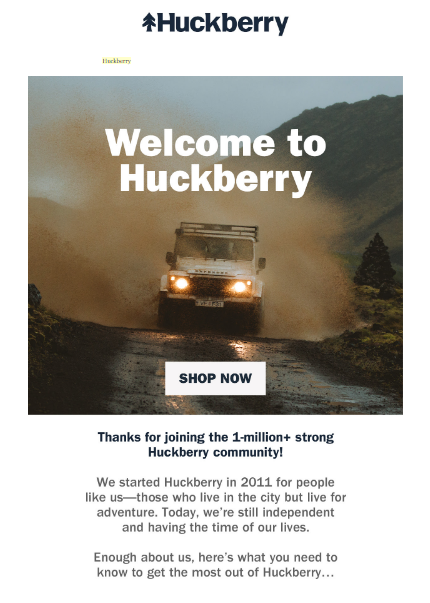
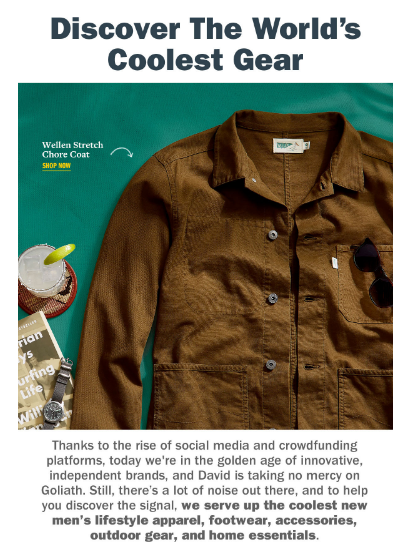
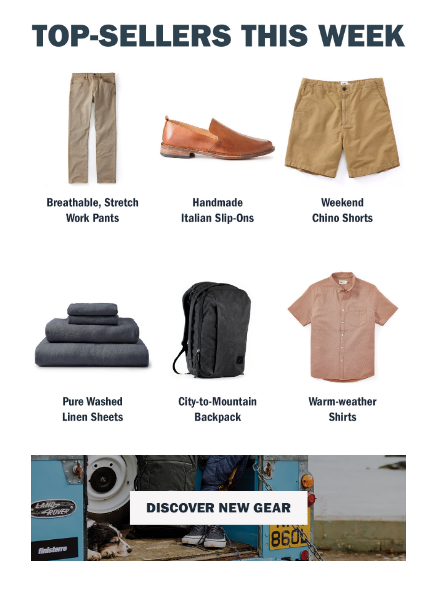
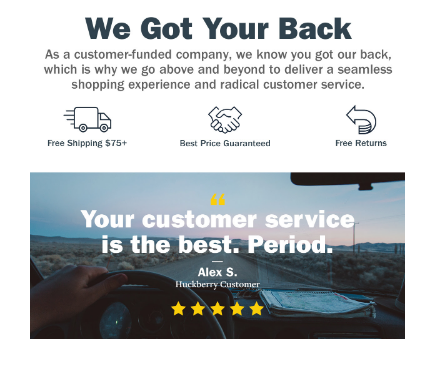
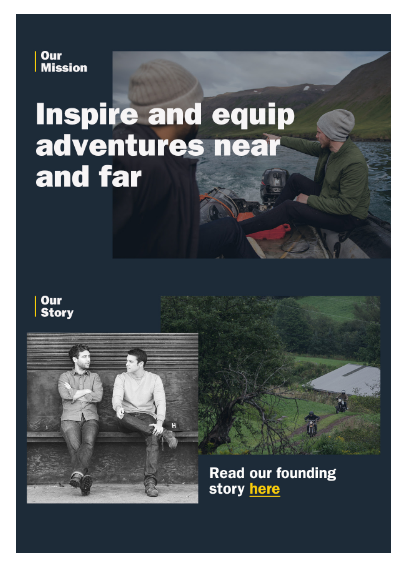
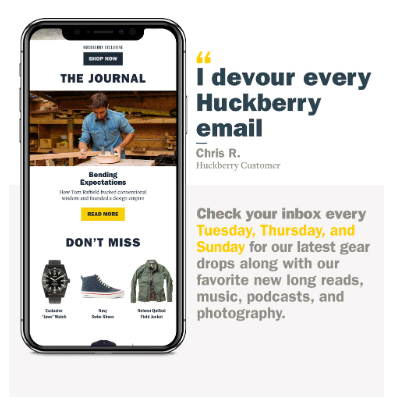
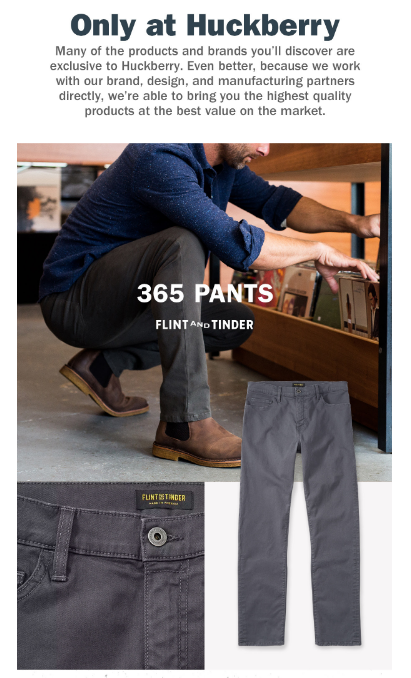
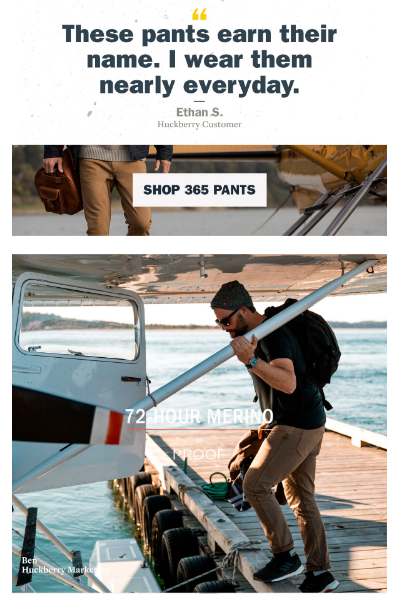
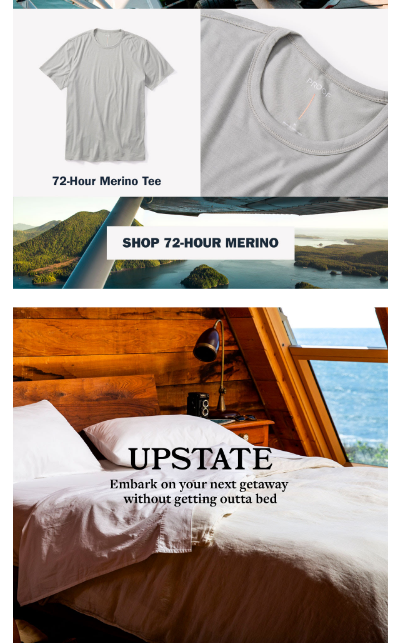
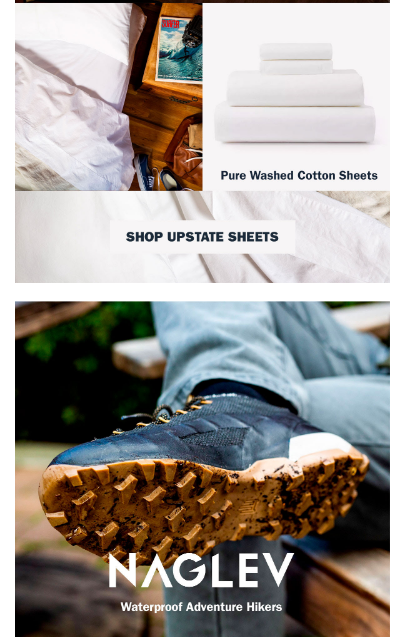
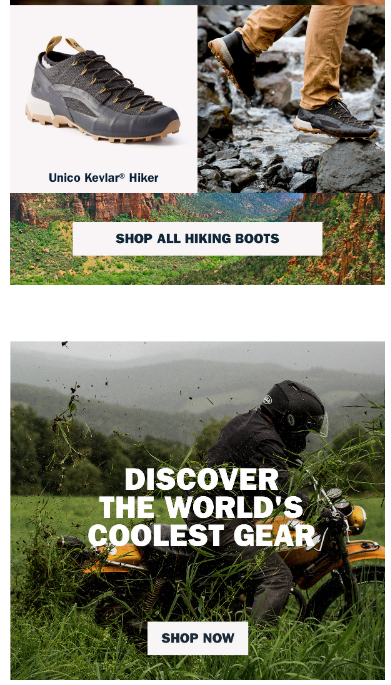
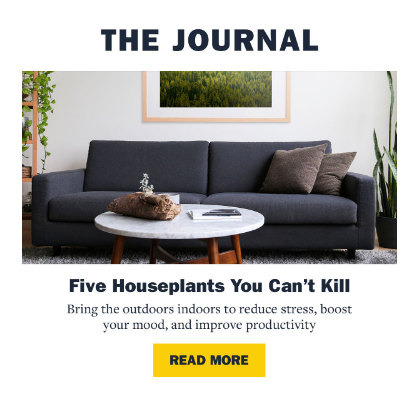
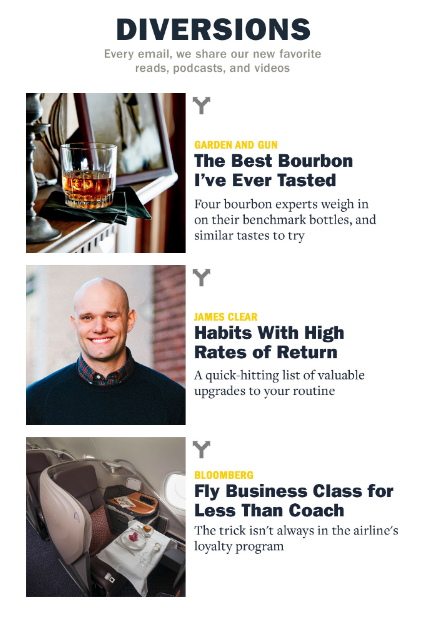
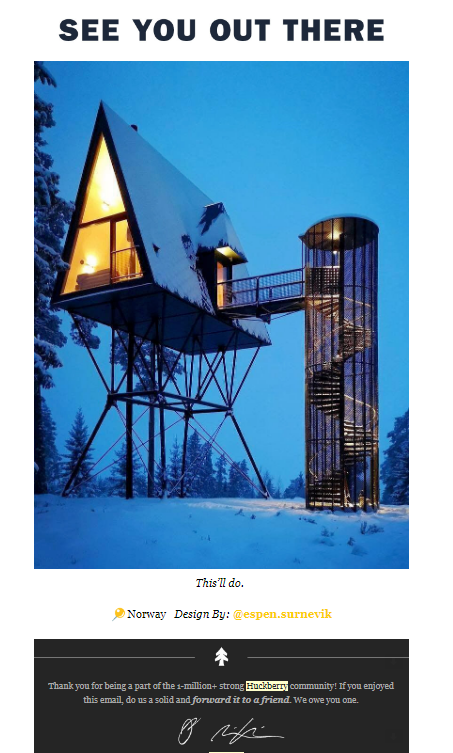
Whew!
That email is certainly longer than the typical welcome email. But it does a ton of things really well. Let us break it down.
It uses loads of social proof

Email marketers should never be afraid to sprinkle compelling social proof throughout their email campaigns — Huckberry’s marketers certainly aren’t. Not surprisingly, 92% of people trust a recommendation from a peer. But more shocking is that 70% of people trust a recommendation from someone they’ve never met before!
The point is, social proof is powerful. And Huckberry doesn’t hesitate to leverage that fact. They sprinkle testimonials about their exceptional customer service, their high-quality products, and even their email campaigns throughout their welcome email with surgeon-like precision, placing each testimonial where it will have the biggest impact.
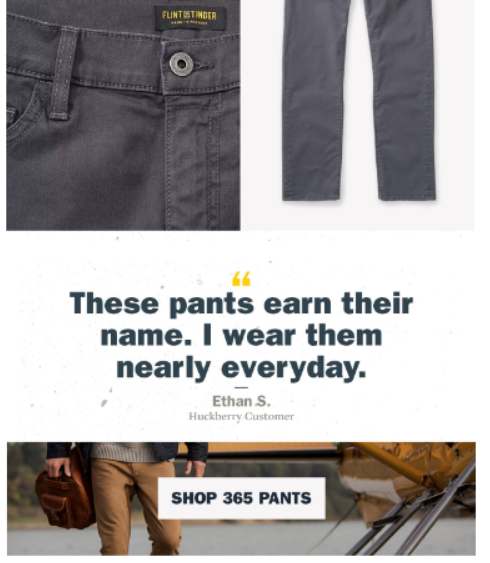
It clearly states the company’s mission
Many email marketers make the mistake of saying “Hi” in their welcome emails and then immediately trying to sell the subscriber something.
The problem is, the subscriber doesn’t even know who you are yet! You have to tell them about your brand, what your company believes in, and what your core values are before you can sell them anything. They have to learn to trust you before they buy from you, and like Simon Sinek famously said, “People don’t buy what you do, they buy why you do it.”
(That’s one of our favorite mantra’s here at Email Mastery — so you’ll see us using it a lot)
Huckberry puts their mission, to “inspire and equip adventures near and far” close to the top of the email…

…and they also provide you with a link to their full story so you can better understand who they are and why they built their business in the first place.
They even put their mission right in the subject line of their welcome email!
![]()
It speaks the subscriber’s language

Huckberry’s marketers make a point to try and speak the language of its subscribers and customers. Even their famous tagline, “See you out there”, is a prime example of how Huckberry works to connect with their audience. Here’s how Micah McKay, Director of Brand Management and Business Development at Huckberry, explains it…
“We try to speak in the language of our customers. ‘See you out there’, for example, is one of the taglines we always use in our emails because we hear customers saying that exact same thing to us.”
In other words, Huckberry works hard to understand its target market and then match their language. That way, Huckberry’s ideal market immediately connects with the brand and the brand messaging — which, down the road, will likely lead to more conversions and revenue generation.
It prioritizes the relationship and the experience over the sale
Huckberry’s marketers understand something that many marketers and salespeople forget. The relationship is more important than the immediate sale because the relationship allows the sale to happen. Without a trusting relationship built upon past reference points, there is no sale.
Which is exactly why Huckberry’s welcome email (and all of their emails, for that matter) work so hard to create value for their subcribers.
Sure, they have the usual sales-y stuff and “Shop Now” CTAs, but they also have loads of value-adding content within their email, including “Diversions” which are meant to entertain and delight their audience. It’s also worth noting that the “Diversions” content doesn’t even lead to Huckberry’s own website, but to other website’s with great content — a perfect example of putting your relationship with your subscribers before your ego.

In the words of McKay,
“We’re not just here to sell. We want to add value to customers’ lives in ways they won’t find from other companies.”
The Huckberry Starter Kit Email
Four days after we received Huckberry’s welcome email, we received a new email with the subject line, “The Huckberry Starter Kit.” Inside, it introduces new subscribers to a variety of Huckberry’s most popular products; from shoes, shirts, and shorts, to whiskey glasses, backpacks, and pocket knives.
Since all of Huckberry’s emails are exceptionally long, we’ve just picked a few snapshots and posted them below.
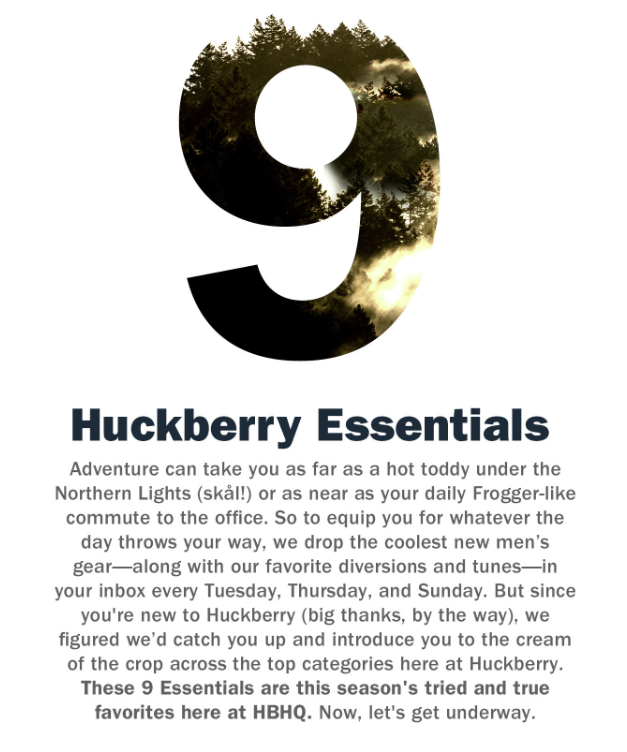
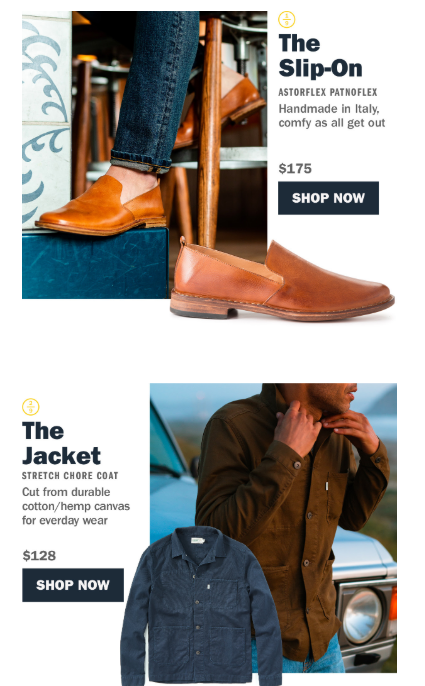

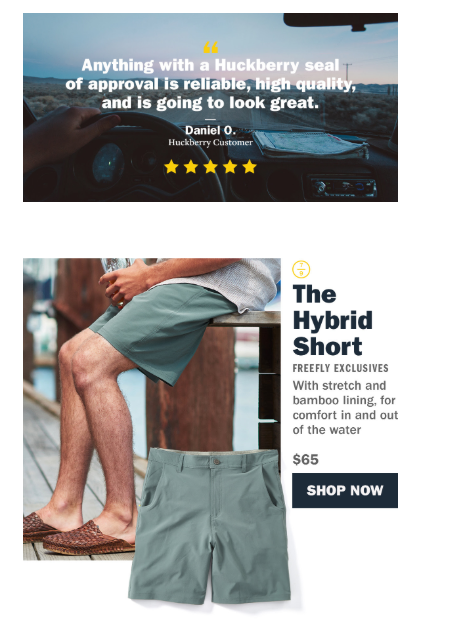
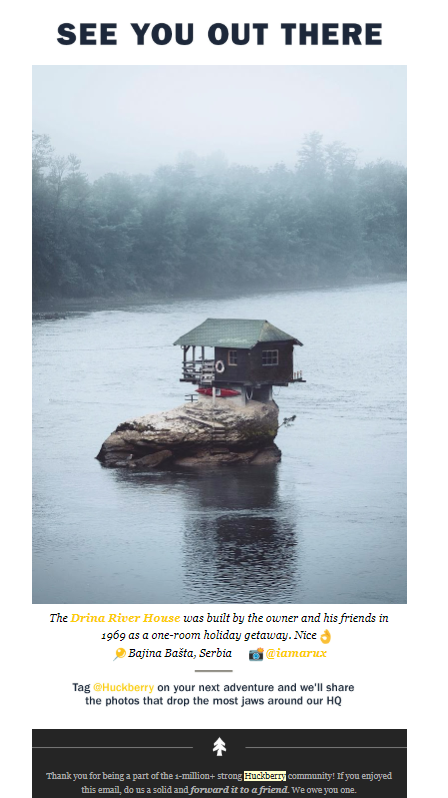
Sending an email which informs new subscribers of Huckberry’s most popular items is a smart move, especially since each of those items within the email is part of a different category. This allows Huckberry’s marketers to segment their email list based on what types of products each subscriber is most interested in. And when they know what products each subscriber most desires, they can then create interest-based recommendations, discounts, and even flash-sales.
Huckberry might not entirely utilize those segmentation strategies mentioned above based on this email, but they certainly could (and you could do something similar!). Our point is just that a lot of segmentation possibilities open up when you send each new subscriber an email which recommends a large variety of products, allowing them to click and indirectly tell you what they’re most interested in.
It’s also worth noting that pretty much every email Huckberry sends includes testimonials about their products and fun “Diversions” (basically, just curated content that their audience might be interested in).
The first — testimonials — is in each email for obvious reasons. Namely, social proof is a powerful tool for selling anything.
And the second — “Diversions” — is probably included because they want to connect with their audience on a deeper level than just trying to “sell them stuff,” as we discussed a bit earlier in this teardown.
Huckberry’s Abandoned Cart Email
Perhaps one of the most critical emails to analyze in any ecommerce email marketing campaign is the abandoned cart email. Some research estimates that about 80% of carts get left behind — a bit shocking. Fortunately, you can recapture at least some of those sales with a triggered abandoned cart email.
For fun, here are the top reasons that consumers claim to abandon cart without buying.
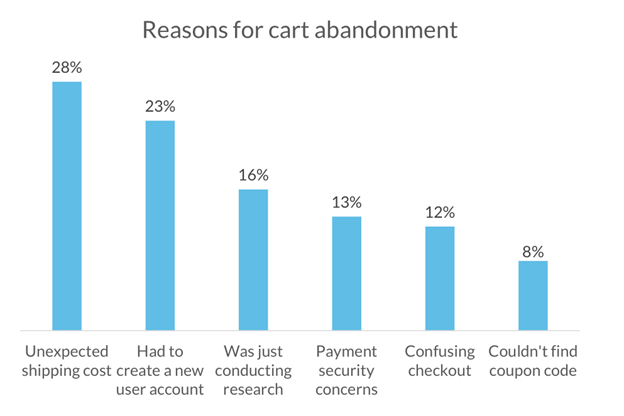
And here is Huckberry’s abandoned cart email.
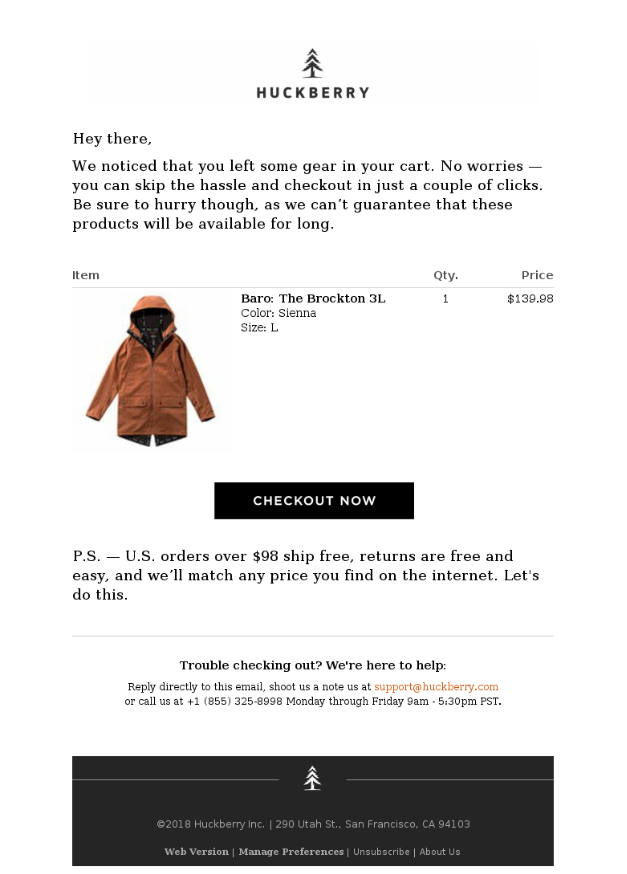
This email hits all of the notes that a great cart abandonment email should hit.
First, we received it within just an hour after abandoning our cart. That is important because the faster you follow up, the better (you should send the first follow-up email between 30 minutes and one hour after the cart is abandoned, according to Optinmonster).
Second, it’s language is non-invasive — that is, it doesn’t feel pushy or aggressive — but it does create urgency by telling me that they “can’t guarantee these products will be available for long.” So if we really want that jacket, we’re probably going to finish our purchase right now.
Finally, in the “P.S.” section, they remind you that they have free shipping on orders of $98 or more, returns are “free and easy,” and they’ll match any cheaper price you find online. Remember up above when we showed you the top reasons that people abandon their cart? Well, this “P.S.” section is perfect for dispelling a lot of those common concerns.
But Huckberry doesn’t stop there. After one more day, we received another email regarding our abandoned cart.
Here it is.
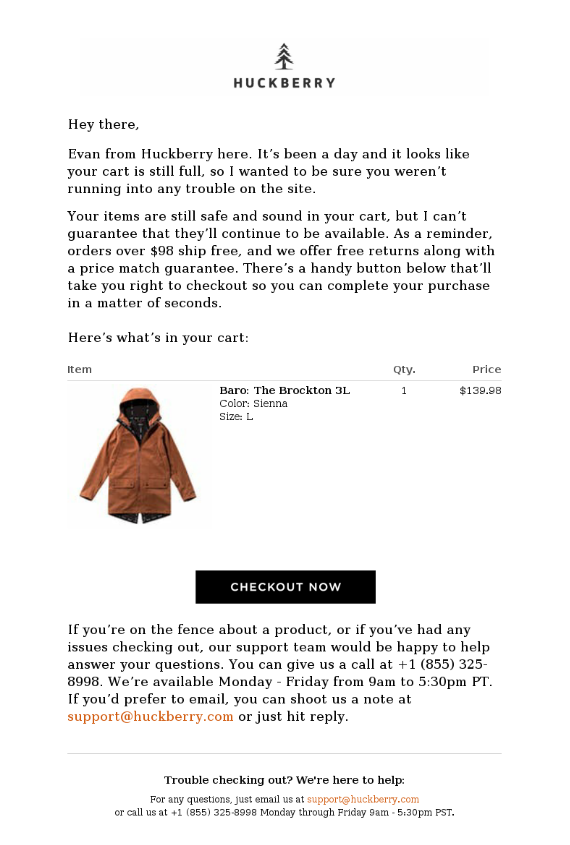
Some marketers might be thinking, “Don’t nag the customer more than once about their abandoned cart!” And that concern has some merit — you probably shouldn’t send the same abandoned cart email everyday for a week. But have two or three evenly spaced emails over a week or two regarding the customer’s un-finished purchase can increase your conversion rate significantly.
In fact, 48% of abandoned cart emails get opened, 21% get clicked, and 10% result in a sale. So it makes sense that you’d want to send a few abandoned cart emails rather than just a single follow up. Just don’t overdo it.
One final thing we want to point out about Huckberry’s abandoned cart emails is that they both address the possibility that the customer is having technical difficulties checking out. This is a good idea. It takes the responsibility for having abandoned the cart off of the customer’s shoulders (so it doesn’t feel like you’re blaming them or pointing fingers) and it also deals with the very real possibility that… well, they are having technical difficulties — almost 20% of people abandon their cart because it was too confusing or they couldn’t figure out how to use their coupon.
And Huckberry seems to ask themselves a wise question that more marketers should ask: why lose sales over technical difficulties when we could just offer to help the customer finish their purchase?
Huckberry’s Email Cadence
Some companies send their email campaigns once per week and some send email campaigns once per day. Any email cadence can work — it really just depends on your company, your customers, and the brand image you’re trying to create.
From what we can tell from being on Huckberry’s email list for a few months now, they send email a bit sporadically, usually with one-, two-, or three-day breaks in between. For example, we received an email on the 20th, 22nd, and 25th of August 2019, and we also received an email on the 5th, 7th, and 8th of September 2019. Ultimately, they send between 2 and 4 emails per week, depending on… what? We’re not so sure. They send on different days each week and different dates each month, always changing the number of emails they send. The only thing that is consistent is that we receive each email right at 9am every single day (which indicates that they’re probably using an email service that can adapt to each subscriber’s timezone).
It’s possible that this is because they want to keep their subscribers on their toes, never quite knowing when to expect a new email — this could work to delight their subscribers and keep the customer-business relationship interesting and exciting.
Plus, the emails they send are always different. They never use the same header image at the top of any two emails. They rarely advertise the same products. And each email is like its own individual experience. You get the sense that every email is hand-crafted by marketers who really care about their audience.
Additionally, the emails that Huckberry sends are never short (with the exception of triggered emails like their abandoned cart campaign). Practically every email they send takes a lot of scrolling to reach the bottom.
We imagine that the reason for this is because they want their subscribers to get lost in the journey of engaging with the Huckberry brand. They want their customers to enjoy not only their products, but their marketing materials themselves. Remember the quote we mentioned from Mckay earlier in this teardown?
“We’re not just here to sell. We want to add value to customers’ lives in ways they won’t find from other companies.”
Each of Huckberry’s emails clearly illustrates that the company doesn’t just want to sell products, it wants to add value to its customer’s lives, it wants to entertain them, it wants to unexpectedly delight them, and it wants each email to be a joy to read. And as the testimonial that Huckberry includes within their welcome email illustrates, it seems to be working: “I devour every Huckberry email.”
We think there’s a lesson here for all email marketers: if you want your subscribers to buy more products, if you want them to trust you, and if you want them to be completely dedicated to your brand, then focus on building a relationship with them — one where you consistently add value without expecting anything in return. As with Huckberry, that relationship will pay you back 10-fold.
Huckberry’s Post-Purchase Email
The last thing we need to discuss about Huckberry’s remarkably relational email campaigns is… what happens when you make a purchase? So we pulled out our wallet, bought something, and monitored the emails.
The first one we received was a receipt email.
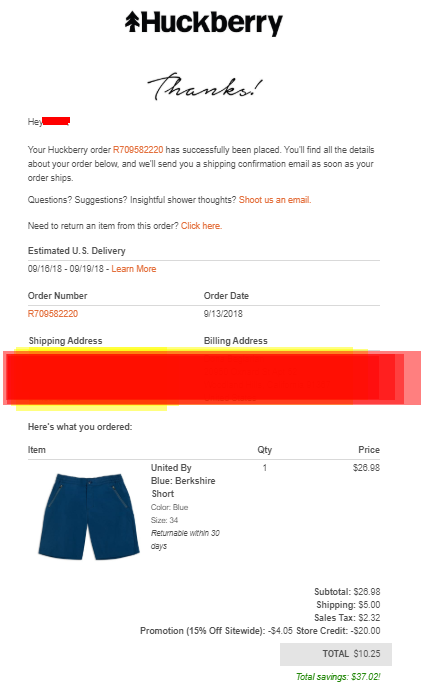
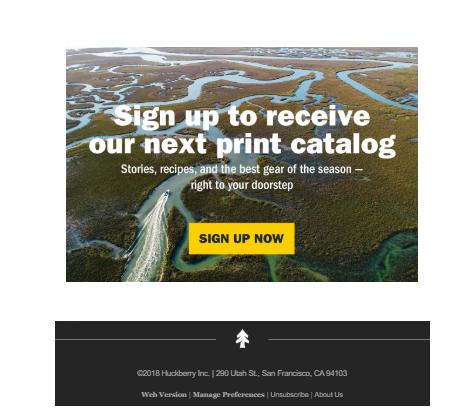
They have a big “Thanks!” at the top of their email (don’t forget to thank your customers for their purchase!), then they give you the order details, and they, most notably, end with a CTA which encourages you to sign up to receive their physical catalogs.
We also received an email when my items shipped. Here’s that email.
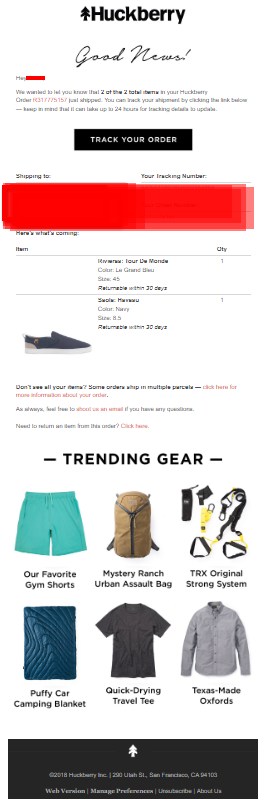
For convenience, they allow you to easily track your order with the click of a button. They also give you your tracking number. And at the bottom, they include some of their currently “Trending Gear” for you to check out if you’re hankering to do some more shopping or browsing.
This is a common strategy for ecommerce companies — to send product recommendations right inside purchase confirmations or shipping alerts. And the reason is, it’s extremely likely that customers who’ve bought once will buy from you again (they already trust you). Statistically, the chance of selling to an existing customer is 12 times more likely than selling to a new customer. So keep up the momentum while you have it.
While Huckberry’s post-purchase emails are relatively basic, they are also quite effective. Don’t let the simplicity of these campaigns distract you from the well-engineered genius of their structure. From the “Thanks!” to the CTA to sign up for their physical catalog and to check out recommended products, Huckberry is taking their customers on a journey from purchasing… to purchasing again in the future.
Conclusion
Ultimately, Huckberry’s email campaigns teach us that building a meaningful relationship with your subscribers isn’t just fulfilling and enjoyable, but it’s remarkably profitable!
After analyzing Huckberry’s emails, it’s no surprise that the company grew so quickly and became a sort-of overnight success. Their emails aim to delight, entertain, and educate their audience. In return, their customers buy, buy, and buy again. They’ve built long-lasting relationships with their subscribers that aren’t easily broken.
You can do the same thing with your audience. By consistently providing value for your subscribers and prioritizing the relationship over an immediate sale, your business will reap the same benefits that Huckberry has — more dedicated customers and a more loyal following.
